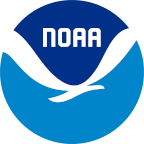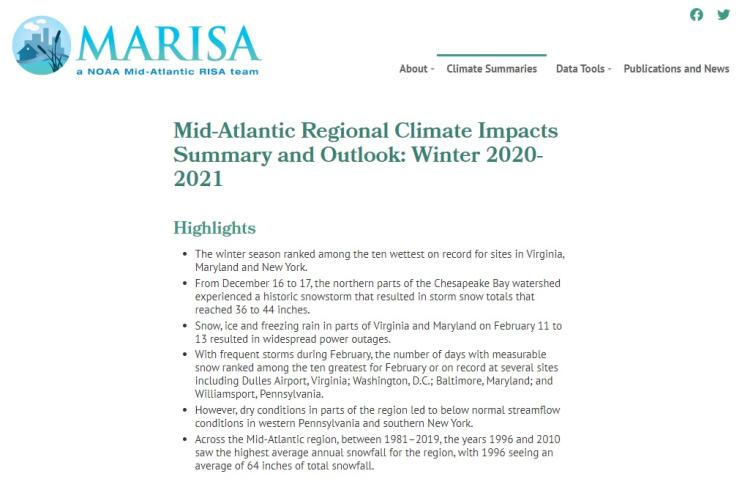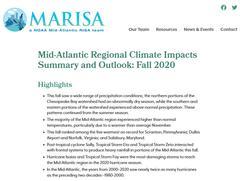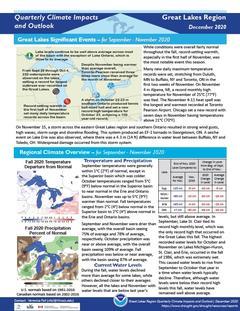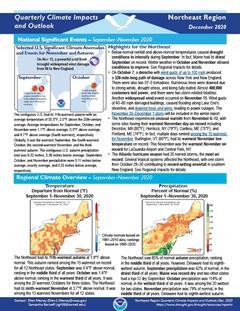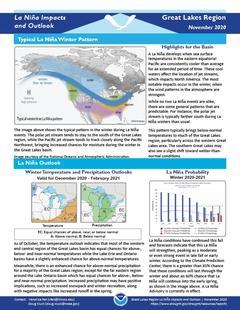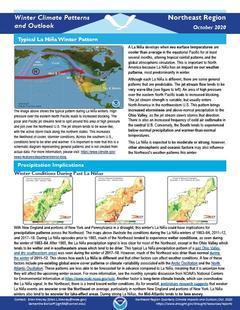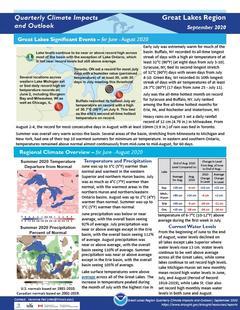Quarterly Climate Impacts and Outlook for the Chesapeake Bay Region for December 2020 – February 2021. Dated March 2021.
Quarterly Climate Impacts and Outlook for the Gulf of Maine Region for December 2020 – February 2021. Dated March 2021.
Winter was up to 5°C (9°F) warmer than normal. Winter precipitation ranged from 50% of normal to 150% of normal. Sea surface temperatures over the entire Gulf of Maine were strongly above normal for the winter season.
Quarterly Climate Impacts and Outlook for the Northeast Region for December 2020 – February 2021. Dated March 2021.
The Northeast had its 20th-warmest winter at 1.8°F above normal and saw 104% of normal winter precipitation, ranking in the middle third of all years.
Quarterly Climate Impacts and Outlook for the Chesapeake Bay Region for September – November 2020. Dated December 2020.
https://www.midatlanticrisa.org/climate-summaries/2020/12.html
Quarterly Climate Impacts and Outlook for the Great Lakes Region for September – November 2020. Dated December 2020.
While conditions were overall fairly normal throughout the fall, record-setting warmth, especially in the first half of November, was the most notable event this season. Fall precipitation was below or near average, with the basin seeing 87% of average.
Quarterly Climate Impacts and Outlook for the Northeast Region for September – November 2020. Dated December 2020.
The Northeast had its 11th-warmest autumn at 1.9°F above normal. This autumn ranked among the 15 warmest on record for all 12 Northeast states. The Northeast saw 85% of normal autumn precipitation, ranking in the middle third of all years.
Quarterly Climate Impacts and Outlook for the Gulf of Maine Region for September – November 2020. Dated December 2020.
Autumn was up to 2°C (4°F) warmer than normal. This autumn was among the 10 warmest on record for Caribou and Portland, ME. Autumn precipitation ranged from 50% of normal to near normal for a majority of the region.
Provides information on the typical La Niña winter pattern; the La Niña outlook; potential winter and spring impacts; and comparisons of conditions during previous La Niña years.
NOAA’s Regional Climate Services Program created these Outlooks to inform the public about climate impacts within their respective regions. Each regional report contains easy-to-understand language, and anyone can access them through the Drought Portal.
Provides a definition of La Nina; a look back at previous La Nina winters; other factors; and the outlook for winter temperatures and precipitation.
NOAA’s Regional Climate Services Program created these Outlooks to inform the public about climate impacts within their respective regions. Each regional report contains easy-to-understand language, and anyone can access them through the Drought Portal.
Quarterly Climate Impacts and Outlook for the Great Lakes Region for June – August 2020. Dated September 2020.
Summer was overall very warm across the basin. Several areas of the basin, stretching from Minnesota to Michigan and New York, had one of their top 10 warmest summers for minimum air temperature. In eastern and southern Ontario, temperatures remained above normal almost continuously from mid-June to mid-August. Summer precipitation was near or above average except in the Erie basin, with the overall basin seeing 105% of average.
